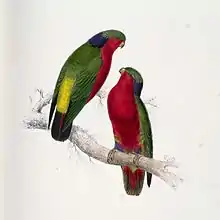Kuhl's lorikeet
Kuhl's lorikeet (Vini kuhlii), also called the Rimitara lorikeet, Kuhl's lory, Manu 'Ura (local appellation) or Kura (Cook islands), is a species of lorikeet in the family Psittaculidae. It is one of several species of Vini lorikeets found in islands ranging across the South Pacific. The Kuhl for whom Nicholas Aylward Vigors named the bird in 1824 was Heinrich Kuhl, a German ornithologist whose survey of the parrots, Conspectus psittacorum, had appeared in 1819.
| Kuhl's lorikeet | |
|---|---|
 | |
| A lithograph by Edward Lear | |
| Scientific classification | |
| Kingdom: | Animalia |
| Phylum: | Chordata |
| Class: | Aves |
| Order: | Psittaciformes |
| Family: | Psittaculidae |
| Genus: | Vini |
| Species: | V. kuhlii |
| Binomial name | |
| Vini kuhlii (Vigors, 1824) | |
| Synonyms | |
|
Coriphilus kuhli (lapsus) | |
Description
It is a fast flying lorikeet with vibrant plumage; a green back, wings and crown, a blue nape and legs and bright red undersides and cheeks.
Habitat
The Kuhl's lorikeet's habitat is natural tropical moist lowland forests and plantations. Like all Vini lorikeets it is a nectarivore, and has a brushy tongue to acquire the nectar. In islands denuded of native forests and covered with extensive coconut plantations it is found exclusively in those areas. It was once present in the Cook Islands but is now restricted to islands of French Polynesia (Only found on the island of Rimatara) and has been introduced in Kiribati.
Status and conservation
Studies of fossils have shown that it once had a widespread distribution from the Cook Islands to French Polynesia. Its range contracted greatly after the arrival of humans, until the only surviving natural population was on Rimatara in the Austral Islands of Southern French Polynesia. Like many island species, Kuhl's lorikeet is threatened by introduced black rats. Its colourful feathers have also meant that the species was regularly hunted. The species was also introduced to several islands in Kiribati. The last native population was protected by a tapu or taboo by Queen Tamaeva V of Rimatara around 1900. In 2007 a population was reintroduced to the black-rat-free island of Atiu in the Cook Islands by the Cook Islands Natural Heritage Trust and numerous conservation bodies, including the San Diego Zoo Institute for Conservation Research.[2] In 2008, the introduced population was found to be reproducing. In 2019, successful reproduction resulted in an estimated population of over 400 individuals on the island of Atiu.[3]
References
- BirdLife International (2016). "Vini kuhlii". IUCN Red List of Threatened Species. 2016: e.T22684630A93038207. doi:10.2305/IUCN.UK.2016-3.RLTS.T22684630A93038207.en.CS1 maint: uses authors parameter (link)
- "Saved by one Queen and Brought Home by Another: Rimatara Lorikeet Returns to the Cook Islands". BirdLife International. 27 September 2007. Retrieved 20 August 2020.
- "Ten years later, rare bird is well established on Atiu". Cook Islands News. 1 May 2017. Retrieved 20 August 2020.
- Chong F, Kape J. (2010). "'Ia ora te 'Ura! Vive le 'Ura! 'Ura, un tres bel oiseau endemique de Rimatara menace", Bulletin de la Société des Études océaniennes, (319): 10–33. Mentioned here http://www.seo.pf/bseo-319.html Volume 311 here http://bibnum.upf.pf/items/show/881#?c=0&m=0&s=0&cv=0 (in French)
- McCormack, G. (2008). The Rimatara Lorikeet or Kura in Atiu (Cook Islands): First Annual Report.
- Steadman, David W. (15 October 2006). Extinction and Biogeography of Tropical Pacific Birds. University of Chicago Press. ISBN 978-0-226-77142-7.
